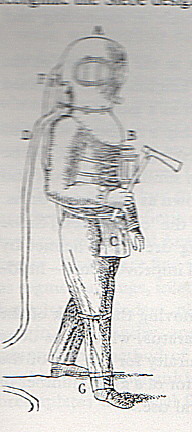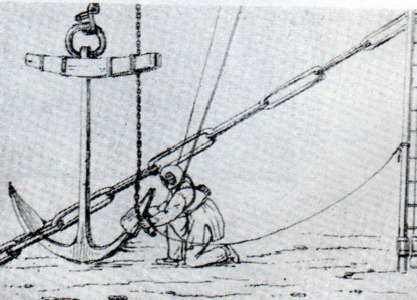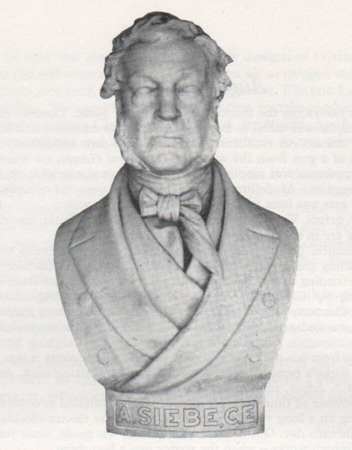
small hatchet for forcing open any door or chest which may conceal or enclose the property to be rescued.
Augustus Siebe was born in 1788 in Saxony. As a young child he was educated in Berlin. After leaving school he became apprentice to a caster. In 1812 he joined the army and fought as a Lieutenant in the artillery at the battle of Leipzig. He became a watch maker for a time before coming to England in 1814 where he became naturalised. Augustus Siebe was mechanical genius and didnít really receive the recognition he deserved as a pioneer in scientific achievements. His main skill was to translate theoretical problems into practical inventions and he was frequently consulted by scholars and academics of the day. Siebeís first notable success was with Deane Brothersí smoke helmet. The helmet had no valves and the helmet was riveted onto a leather jacket. There were 2 pipes, one supplying fresh air from a blacksmithís bellows and the other, tethered to the wearerís ankle took away the contaminated air.
 |
| The
original description reads: the wearer carries a lanthorn (lantern)
strapped in front of his veste and a small hatchet for forcing open any door or chest which may conceal or enclose the property to be rescued. |
Following the success of the smoke helmet Siebe designed a light metal helmet attached to a waterproof jacket which reached to the wearerís waist . This became the Siebe open diving dress. The diver had to work in an erect position and should he be required to stoop he would have to adopt a bent knee position.

Although the open dress diving suit was relative
success, Siebe with Deane , now a diver was not satisfied that this equipment
fully exploited the concept of the diverís dress and in 1829 the closed dress
was developed. This development meant the diver could work in any position in
comfort and safety. The helmet part was made separately from the breastplate and
connected by a segmental thread and valves were added and the design was
improved upon.
As well as developing the diving dress Augustus Siebe had already designed and
developed the breach loading gun in 1819.
Siebe also patented a weighing balance machine. This machine could also be used
to measure the speed of a ship by trailing a float behind and by measuring the
resistance in passing through the water the speed could be calculated.
Another invention of Siebeís was the tap for cutting hollow screws.
Although hydraulic machines were already in use, Siebe patented an improvement
for these machines making them more efficient and longer lasting as well as
being more effective.
In 1850 Augustus Siebe started to manufacture
refrigeration equipment under a licence from the Australian, James Harrison.
An ice making machine exhibited by Augustusís grandson Daniel Siebe at the
London Exhibition was capable of converting 1 ľ tons of water into solid blocks
of ice without the use of chemicals. The main application of this machine was
that of a rudimentary air conditioning device.
Other notable achievements were the manufacture and patent of a height and
weight machine and a paper making machine.
Augustus Siebe also developed a method of welding iron and steel plate by the
discovery of borax as a flux.
For all these discoveries, inventions and developments Augustus Siebe received
many testimonials from the Society of Arts but there is little doubt that he is
best remembered for the development of the closed dress diving suit which was
successfully used for the salvage of the Royal George.
In 1782 the 104 gun warship Royal George sank at Spithead. In 1839 major General
Paisley was charged with the removal of the Royal George along with the Edgar
which had sunk in 1711. Over the next few years Siebe was to refine his air pump
and diving helmet making the salvage work both safer and quicker.
He received many testimonials for the equipment notably from Major General
Paisley, H Jekyll Lieutenant, Royal Engineers,
Various dockyards, Divers, Royal Navy Captains and many others. Robert Louis
Stevenson the renowned author famously made a descent in Wick harbour wearing
Augustus Siebe diving apparatus.
On the 15th of April in 1872 Augustus Siebe died. The firm of Siebe & Gorman
continued under the management of Henry Siebe and William Gorman.
 |
| Augustus
Siebe-The Godfather of Diving 1788-1872 |